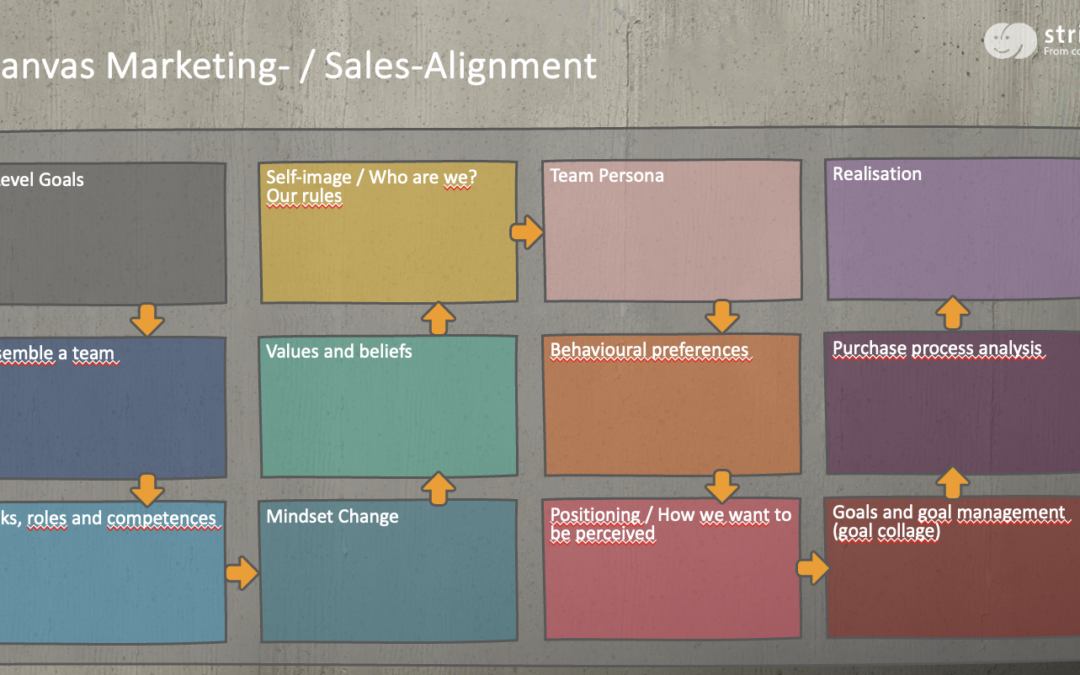Marketing-Sales Alignment 4.0 – How to get marketing and sales out of silos and develop high-performance teams
Sales is facing major challenges today. In addition to the classic challenges, sales also has to overcome some new ones:
- Customers search, decide and buy differently today than in the past
- Customer expectations have changed (approach, content, formats, processes, etc.)
- Customers move at many more touchpoints than in the past
The opportunities for modern sales have never been greater. But sales cannot realise them alone. Optimal sales success can only be generated in a team with marketing.
In practice, however, the situation is still different in many companies today. The departments live and act separately from a large gap and do not really work together. This gap between marketing and sales is the biggest obstacle to success in B2B companies.
Some of the most serious brakes on optimal collaboration:
- Marketing and sales live in separate silos
- There is little or no coordination
- The departments work with different systems
- Motivations, goals and incentives are too different
- The view and assessment of data are different
- The perspectives on the market and on customers differ
- and unfortunately there are a few more
Today, it is no longer appropriate or expedient to allow the two areas to operate in their own silos. In order to break down these silos and achieve optimum sales power, however, it is not enough to simply talk about smarketing or just talk more often.
Today, marketing and sales must work together optimally as a team, as a high-performance team. Not only to exploit the potential of digitalisation, but also to support all areas of traditional marketing. It is more effective to form cross-functional high-performance teams for each sales objective. This is the only way to activate the full potential and increase sales success.
Important aspects that support effective team building are:
- Safety: Every team member must have the feeling that they are working in a safe environment. This includes being allowed to make mistakes, being able to admit weaknesses and dealing productively with failure.
- Meaningfulness / purpose: If people lack a sense of purpose in their work, this has a negative impact on stress levels and motivation. In a good team, every team member must be able to grasp the meaningfulness of the goals and actions.
- Bonding: Contact with other people is fundamental for us as social beings. If you feel comfortable in a team and experience support within the team, this contributes to your mental well-being, motivation and performance.
- Transparent and open communication: Open and unconditional exchange, clarity, honesty
- Structures: Organising participation, structures, meetings, jour fixes
In my new canvas model and concept for consulting, in-house training and open seminars, I combine the technical aspects with elements from mental coaching, behavioural preferences, emotional intelligence, meta-programmes and creativity techniques.
It contains the following elements:
1) C-Level goals
What tasks or goals should the team achieve? / Our mission?
The C-level defines the goals – ideally based on the corporate strategy – that the team should achieve, or the topic or sales scenario that the team should work on. It is important to really concretise the goals and break them down to the team goal.
Topics can be
- Lead generation / optimising new customer acquisition
- Increase the repurchase rate (repeat selling). E.g. selling more machines of the same type
- Up-selling: Selling a higher-value offer. E.g. selling a larger or more powerful machine
- Cross-selling: Selling extensions or additions to the product sold. E.g. packaging module for the machine
- Account based marketing / ABM: Winning and penetrating target customers
- Churn: Prevent or reduce customer churn
A team leader or core team is tasked with putting together a cross-functional team, developing a strategy, creating a plan and implementing it.
2) Team composition
Who do we need to make up our team? Which people with which knowledge are needed from which areas?
Exemplary areas:
- Sales
- Account Management
- Key Account Management
- Back office
- Marketing
- Service
- Product Management
Exemplary areas of knowledge, knowledge about:
- Customers
- Industry
- Countries
- Specialist topics
- Products / services
- Processes
- data
- Content
- Touchpoints
- Technology / systems
- Legal aspects
3) Tasks, roles and competences
What tasks are to be fulfilled and what competences are required for this? Who takes on which roles?
In every marketing and sales scenario, there are various tasks that are relevant for achieving the team goal or team task. Exemplary tasks:
- Team leadership
- Project management
- Strategy
- Input Knowledge, experience, insights from the market and customers
- Content conception and creation
- Performance measures
- Touchpoint management
- Measure and optimise
- Documentation
- Data management and data analysis
- Handling technology / systems / system integration
Competences
Which competences are still required to fulfil the order? Which can be built up internally and which must be organised externally?
4) Self-image: Who are we? Our rules
What self-image and rules does the team have?
A group of people working together is by no means a team. A good team has a clear picture of itself and is aware of the strengths and weaknesses within the team. The team has defined rules and routines for working together and their actions.
5) Values and beliefs
What are the team’s values and beliefs?
Our values describe what we consider to be positive and morally good. Sharing individual values within the team increases understanding of the other team members and also serves as a basis for the team’s shared values.
Negative beliefs and convictions stand in the way of good cooperation and team success. If you are aware of these beliefs and convictions, you can take countermeasures and formulate positive beliefs for team success.
6) Mindset change
How does the team leave old perspectives and silos behind and come together as a team? How does the team solve problems and find new ideas and solutions?
As most people in marketing and sales only know the old ‘silo world’, the separate goals, perspectives and activities, it is important to expand this old setting with a new mindset of the cross-functional team. Mental coaching methods are very suitable for this. Profiling a team persona (corporate persona) also contributes to the mindshift.
7) Corporate / team persona
The team profiles itself as a team persona
A team persona is used to present the team as a persona. With information such as profile data, target states, challenges, positive and negative performance factors and behavioural preferences.
8) Behavioural preferences
What behavioural preferences and motivators are there in the team and how are these optimally used to achieve goals?
Everyone has different preferences for how they react to their environment and events – behavioural preferences. If all team members know the behavioural preferences in the team, this optimises communication, understanding and behavioural options. By analysing the ‘driving forces’, the team members recognise the motivators and know what motivates whom and how. Emotional intelligence is an important success factor in business. The diagnosis of the four areas of emotional intelligence is another interesting tool for testing success.
9) Positioning
How does the team want to be perceived?
And how does the team position the company in the context of the team’s mission? The team answers the questions of why and why they are there with the company’s offer and what benefits they provide. They explain how the company satisfies the needs of its customers.
10) Goals and goal management
How does the team work towards its goals?
Goals are not just numbers. Goals can have a great influence on the motivation of team members. In target management, the team works with target images and visualisations of success.
11) Sales process analysis
How are the processes organised in relevant sales scenarios?
The team defines the relevant processes for the target task and plans the relevant elements:
- Buyer Persona Profile
- Customer journey analysis
- Nurturing processes
- Content
- Approach
- Performance
- Touchpoints
- etc.
in a target-orientated implementation roadmap.
12) Realisation
How are the activities to achieve the objectives implemented?
The implementation is initiated and supported by the team. This includes topics such as
- Technical aspects (systems and system integration)
- Data management (data cleansing, data enrichment)
- Setting up and monitoring processes
- Measurement and optimisation
- Legal aspects
- Performance measures
- Scaling and transferring results and findings to other teams and business units
Conclusion:
Marketing and sales need to work more closely together today. To achieve this, the areas (marketing and sales, but also service and product management, depending on the sales scenario) must leave the silo mentality and really come together to form cross-functional teams.
Advantages of optimised cooperation between marketing and sales:
- The probability of closing / success increases
- Sales scenarios are initiated more stringently and implemented better in practice
- Motivation in the team increases
- Opportunities and resources are utilised more optimally
- Lone fighters become high-performance teams


